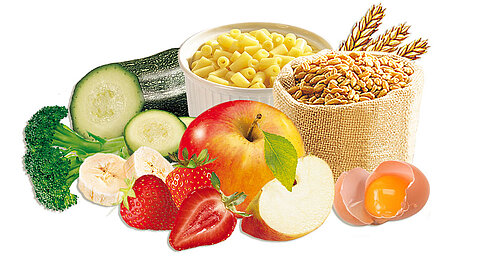Lactose intolerance

Milk and dairy products are especially important for your child's healthy growth because they are a rich source of calcium, which is necessary for the healthy growth of your little one's bones.
However, some children experience problems with the lactose in milk. This is because your body cannot process lactose properly (lactose intolerance). Such intolerance usually manifests itself as abdominal pain, gas, or diarrhea.
What is lactose intolerance?
Lactose intolerance is the situation where discomfort occurs after the consumption of lactose ("milk sugar"). Lactose is a natural carbohydrate found in all dairy products.
People with lactose intolerance cannot digest lactose because the enzyme lactase, which is needed to digest lactose, is not present in sufficient quantity. Because of this, lactose does not divide properly into glucose and galactose, and arrives undigested in large quantities in the large intestine. There the lactose is metabolized by the intestinal flora, forming gas, or diarrhea and abdominal pain after consumption of dairy products.
People with lactose intolerance are not sick, but they should pay special attention to their diet. For example, to avoid discomfort, it is usually necessary to minimize the intake of lactose, but at the same time milk and milk products should not be avoided completely, as they provide important nutrients. To meet the needs of people with lactose intolerance, special products are available without or in low quantities.
Lactose intolerance is very common, approximately 20% of the Mexican population is affected.
Why the body needs lactose for?
Lactose is the main carbohydrate in mammalian milk. Breast milk is also high in lactose (approximately 7g/100 ml), making it one of the most important sources of energy for your baby. During digestion, the lactose reaches the small intestine, where it splits into its glucose and galactose components. These components then enter the bloodstream through the intestinal wall and are used by cells to produce energy. In addition, lactose promotes the development of a healthy intestinal flora in infants.
Babies of nursing age can usually digest lactose very well. But there are very rare cases of lactose intolerance. However, as a person ages, the ability to digest lactose decreases and is called "primary lactase deficiency" develops. This is the most common form of lactose intolerance and can cause symptoms from childhood. If you experience discomfort from dairy, it is important to see your doctor.
My child suffers from lactose intolerance?

Possible symptoms and test methods
Lactose intolerance manifests itself as discomfort in the gastrointestinal tract that occurs after the consumption of milk and milk products. Possible symptoms include gas, abdominal pain, diarrhea, and nausea.
Symptoms depend largely on a person's lactose intolerance and are usually nonspecific.
If you suspect any of the symptoms, consult your pediatrician to rule them out.
The pediatrician can confirm suspected lactose intolerance through common testing procedures.
One of these tests is the lactose post-breath test (hydrogen breath test). This test is very reliable and is suitable for young children over the age of one. It consists of the child taking a lactose solution on an empty stomach. In the next few hours, the hydrogen content of the exhaled air is measured.
What is intolerance, what is allergy?
Food allergy is very different from food intolerance. Food allergy always involves the immune system. In it, the immune system responds with a defense reaction to certain substances (proteins) that are harmless to a healthy person. Usually the minimum amounts ("traces") are enough to trigger a reaction. Typical symptoms of an allergy include sneezing, skin rashes and itching, red eyes and difficulty breathing.
In the case of food intolerance the immune system is not affected. One cause may be, for example, non-optimal or lacking activity of digestive enzymes in the intestine, which can lead to a variety of symptoms in the gastrointestinal tract when the corresponding food is taken. The amount of food consumed is very important. So, in contrast to food allergy, small amounts are generally well tolerated.
When consumption of cow's milk causes a reaction, it is important to distinguish between true cow's milk protein allergy and lactose intolerance:
In the case of an allergy to cow's milk protein, cow's milk should be avoided completely and you should consult your doctor to find a calcium-rich alternative.
In the case of lactose intolerance, on the other hand, milk and milk products can be tolerated to a certain degree. Some people can drink half a cup of milk or yogurt without any problem, while others react to even minimal amounts. In lactose intolerance, the body has difficulty breaking down the lactose contained in food. In these cases, lactose-free products can be recommended.
In cases of suspected allergy to cow's milk protein or lactose intolerance, it is important to consult your doctor as soon as possible. The doctor will make a diagnosis and tell you the real result.
Should milk be avoided completely if you are lactose intolerant?

Many people believe that their lactose intolerance forces them to avoid milk altogether and to eat a diet that does not include dairy products. However, this is not necessary, since even with cases of acute lactose intolerance, a certain amount of lactose is tolerated without any adverse reaction.
Milk and dairy products contain many healthy nutrients, especially an important source of calcium. So, avoiding them would be a problem, especially for young children who need sufficient calcium intake for healthy bone formation. In childhood, bone growth is particularly important.
If you want or need a low lactose diet during childhood, you cannot simply avoid milk and milk products, but rather include lactose-free milk products in your diet.
Before using lactose-free formulas, you should consult your pediatrician. He will determine if this type of diet is right for your little one.
Living with lactose intolerance
If you or your child has been diagnosed as lactose intolerant, you should change your child's diet. Lactose intolerance is not curable, but a careful diet usually prevents symptoms completely.
First, avoid foods that contain lactose to soothe the intestines. After some time, the consumption of small amounts of lactose can be resumed. The amount should reflect the degree of intolerance. This serves to analyze how much lactose the body can tolerate, at what time of day, in what amount and with what other foods. Consumption of lactose as part of a meal tends to be better tolerated than between meals. Dairy products such as cheese contain very little lactose and are generally very well tolerated. Yogurt is also a healthy alternative that is generally very well tolerated, especially in small amounts.
No one needs to restrict their dairy intake for the rest of their life, but sensible management is recommended. To minimize the inconvenience, a wide variety of lactose-free products are available today.
| Feta cheese, 45% fat | By weight 0.5g Lactose/100g |
| Butter 0.6 g | Lactose/100g |
| Sliced cheese, soft cheese, hard cheese < 1 g | Lactose/100g |
| Créme fraiche 2.0-3.6 g | Lactose/100g |
| Cream cheese, 10-70% fat 2.0-3.8 g | Lactose/100g |
| Curd 2.5-3.2 g | Lactose/100g |
| Cottage cheese 2.5-3.4 g | Lactose/100g |
| Sour cream 3.0 g | Lactose/100g |
| Yoghurt 3.2-5.6 g | Lactose/100g |
| Cream, 30% fat 3.3 g | Lactose/100g |
| Cheese spread 3.4-7.5 g | Lactose/100g |
| Desserts (Creams, Pudding, Rice pudding, etc.) 3.5-6.0 g | Lactose/100g |
| Whey 4.0 g | Lactose/100g |
| Sour milk, Kefir 4.0 g | Lactose/100g |
| Goat's milk 4.2 g | Lactose/100g |
| Milkshakes 4.4-5.4 g | Lactose/100g |
| Whey/serum 4.7 g | Lactose/100g |
| Cow's milk 4.8 g | Lactose/100g |
| Ice cream 5-7 g | Lactose/100g |
| Chocolate 9.5 g | Lactose/100g |
| Milk powder 38.0-51.5 g | Lactose/100g |



